Circulators are special pumps which are used to circulate a substance through a closed loop system. A common use is in central heating systems, with the function of transporting hot water. In the product study for circulators, two base cases were identified: standalone and boiler integrated devices. Both types are included in the final Ecodesign regulation.
The circulator pumps included in the regulations are ‘glandless’, which means that the sha# of the motor is directly coupled to the pump, while ‘glanded’ circulators have an external sha# to which the motor can be attached. This specification was introduced to prevent an overlap with the Ecodesign regulation for ‘Pumps’.
Source: estimations from the Ecodesign Impact Accounting Overview Report 2024
Scope
Under the Regulation, a circulator is defined as ‘an impeller pump, with or without pump housing, which has the rated hydraulic output power of between 1 W and 2 500 W and is designed for use in heating systems or in secondary circuits of cooling distribution systems.
The following table shows some examples of products in scope and out of scope in the Ecodesign Regulation:
| In Scope | Out of Scope |
|---|---|
|
|
Check the complete list in the Ecodesign Regulation.
Ecodesign Requirements
Ecodesign requirements apply to circulators placed on the EU market. These requirements cover:
- energy efficiency
- product information
Highlights
Circulators - pump devices used to circulate a fluid in a closed system, such as hot water in heating systems or cooling water in cooling distribution systems – are subject to EU ecodesign requirements. By 2030, energy efficiency rules for circulators will lead to annual energy savings of 14 TWh in the European Union, reducing CO2 emissions by 1 million tonnes.
The regulation also covers circulators built into other products, such as boilers. It does not cover drinking water circulators.
Facts & Figures
This graphic shows the estimated sales, stock, energy consumption (primary, electric or fuel), greenhouse gas emissions, consumer expenses and business revenues for years 2010 and 2030. The estimated values inside the graph bars are those from the EIA ECO-scenario, they include the effects of Ecodesign and Energy Labelling measures.
The difference with the business as usual (BAU) scenario without these estimated measures is shown next to the graph bar. These figures indicate the estimated savings obtained due to the measures.
Product: Circulators Measures: Regulation (EU) 641/2009, CR (EU) 622/2012 [amendment] |
|---|
| The striped lines in the charts show the 'Effect of the Regulations' |
SALES (x1000/a units) 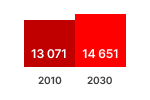 | STOCK (x1000 units) 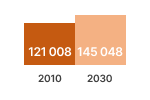 | Electricity (TWh/a) 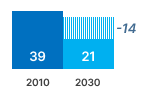 |
GHG-EMISSION 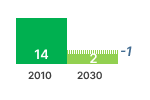 | CONSUMER EXPENSES 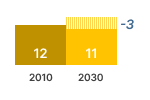 | REVENUES 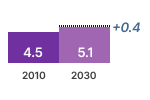 |
Source: estimations from the Ecodesign Impact Accounting Overview Report 2024
In 2020, 137 million Circulators were in use in the EU27, of which 60% integrated in central heating boilers, and 40% standalone.
The total fluid energy output of the circulators was 20.8 TWh in 2020. This corresponds to moving 47.4 million litres per second of water at a speed of 1 meter per second through 100 m long copper pipes with a diameter of 15 mm during 5000 hours per year. This means that the average circulator moved nearly 30 thousand litres of water per day for 208 days per year.
To perform this job, the circulators used 24.4 TWh of electricity. This is 1.0% of the EU27 total electricity consumption in 2020, and close to the consumption of Slovakia (23.8 TWh).
The average integrated circulator sold in 1990 consumed 303 kWh per year of electricity. Without measures, this would have decreased to 231 kWh in 2020, but due to Ecodesign regulation it was further improved to 135 kWh (-42%), mainly due to better dimensioning and to enhancement of controls. For 2030, a further reduction to 128 kWh per year is projected.
In 2020, for small standalone circulators the improvement is from 148 to 72 kWh/a (-51%), and for large standalone circulators from 1144 to 744 kWh/a (-35%).
Regulations saved 12.5 TWh of electricity in 2020 (-34%), projected to increase to 13.9 TWh in 2030 (-40%).
The 2020 savings are 0.55% of the total EU27 electricity consumption in 2020, and close to the consumption of Slovenia (13.0 TWh).
Due to Ecodesign, EU27 users saved € 1.5 billion on circulators in 2020 (-12%), projected to increase to € 2.9 billion in 2030 (-21%).
In 2030, the annual household expenses for circulators decrease from € 47 to € 37.
Expected Savings
Circulators are a typical example where forward-looking manufacturers, pressed the Commission to investigate the eligibility for an Ecodesign regulation for their products, because they believe that ambitious standards in energy efficiency are not only good for the environment but also good for business.
Circulator pumps up to 2.5 kW are typically, but not exclusively, used to pump water through (closed) central heating systems. Although power consumption may be limited, they are ubiquitous and have very long operating hours (typically 5000 hours per year). They may be a component in a heating boiler (‘integrated’), or used as a standalone product mounted by the installer somewhere in the heating circuit.
At the time when the Commission first investigated the product in 2008 - 2009, their electricity consumption amounted to 39 TWh/year, comparable to e.g. the energy use of washing machines in the EU in 2010 (36 TWh/a). Furthermore, the energy saving potential was substantial due to the tendency in the sector to vastly over-dimension the circulator and use only basic controls. The new metrics of the Ecodesign regulation played an important role in transforming the market, with a drop in electricity use to 33 TWh/a in 2015, 24 TWh/a in 2020 and projected 21 TWh/a in 2030. This is a 40% saving in electricity and CO2 emissions, while at the same time the product contributed to achieving a higher heating comfort.
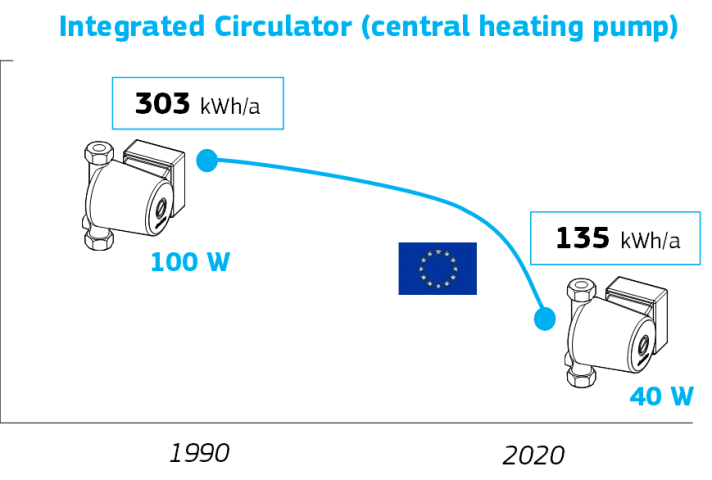
Source: estimations from the Ecodesign Impact Accounting Overview Report 2024
Note about double counting: some circulators covered by the Regulation are incorporated in products covered by other ecodesign Regulations (e.g. boilers). Therefore, a part of the energy consumption / savings shown here is also included in the figures of these other products, leading to a form of double counting. The double counting effect is already accounted for in the figures above (the values shown here need to be multiplied by 2.63 to get the non-double counted values).

Policy
Ongoing legislative work
Please check the ongoing initiatives on the Have your say portal.
The legal framework is Commission Regulation (EC) 641/2009 of 22 July 2009 implementing Directive 2005/32/EC of the European Parliament and of the Council with regard to Ecodesign requirements for glandless standalone circulators and glandless circulators integrated in products.
Disclaimer: please pay attention to possible updates/changes as indicated in the Official Journal (green dot)

